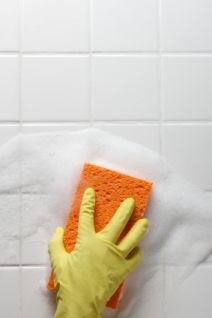Although tile and grout can provide an attractive and durable household surface – especially in kitchens and bathrooms – they need to be maintained to avoid discoloration and/or germ infestation. When cleaning and disinfecting, it’s important to consider how the surface will react to the various compounds and methods you plan to use. For example, most tiles have an impervious finish that can be cleaned with a basic cleaning solution, but grout could require a specific agent that is effective on its porous surface.
Never commit to cleaning an entire floor or wall until you’ve experimented on an obscure patch. It’s always wise to work up from a simple solution to a stronger formula. If you’re looking for a natural solution, try using equal parts vinegar and water. The combination works well on finished tile, but be careful not to let it come into contact with unprotected natural stone or wood. To escalate your attack, mix a paste of three parts baking soda and one part water, then apply the paste to the grout lines before introducing a narrow spray of diluted vinegar to create a naturally effervescent agent. If natural household cleaners are ineffective, ask your home centre or hardware store for a stronger recommendation.

